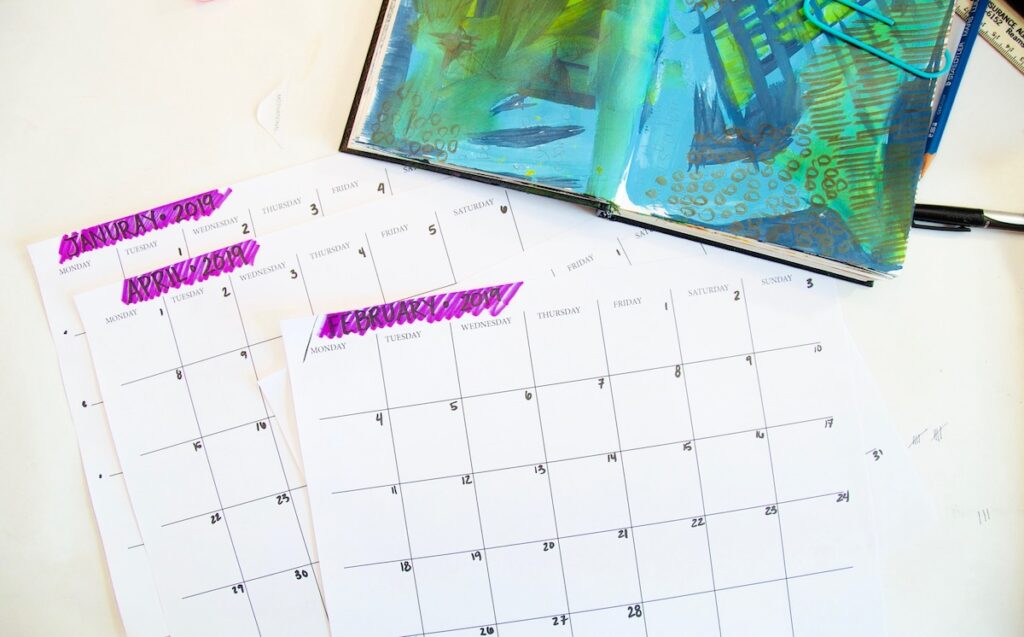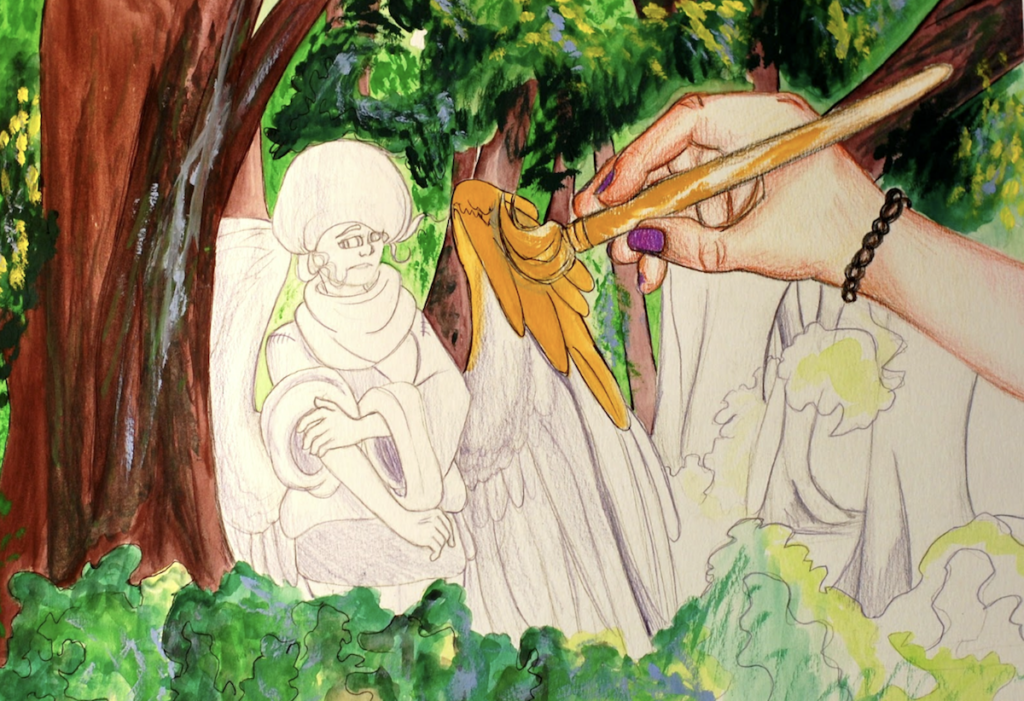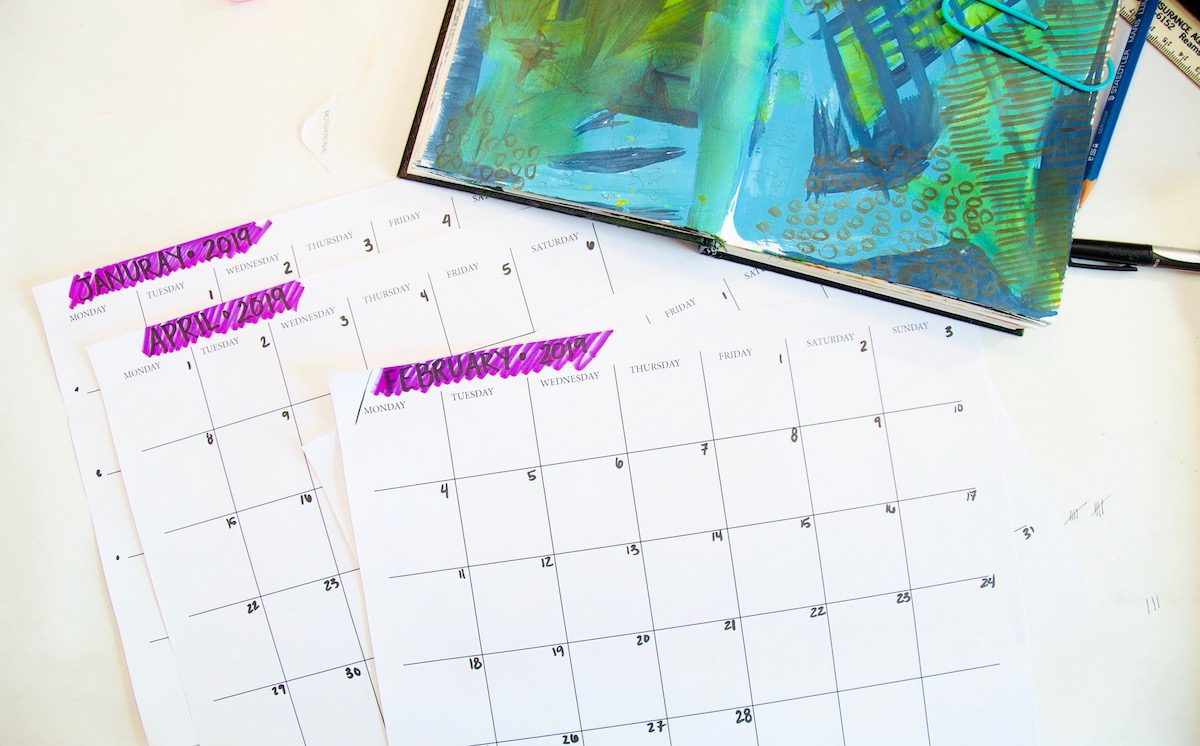In 2018, College Board changed the requirements and structure for Advanced Placement Studio Art courses, now called AP Art and Design. While this article addresses the old portfolio expectations, there are still many applications for advanced students looking to build a portfolio. Refer to College Board to stay informed on the latest updates.
Teaching AP Art is exciting and fun, but can also be overwhelming.
It’s one thing to write a plan of action on paper and another to translate it to the moods and motivation of your students. But it can be done! The growth shown over time is worth the effort.
If you’re not familiar with Advanced Placement Art courses, here’s a quick overview.
There are four courses: AP Drawing, AP 2-D Design, AP 3-D Design, and AP Art History. The first three require portfolio submissions, while the last requires students to sit for an exam.
Today we’ll focus on planning for AP Drawing and AP 2-D Design.

AP portfolios consist of three categories: concentration, breadth, and quality.
Concentration
The concentration section is twelve works of art that connect to a central idea. The pieces are to show growth and transformation from start to finish. These pieces are photographed and/or scanned and submitted digitally.
Breadth
Next, the breadth is another twelve pieces that demonstrate a range of approaches. These pieces don’t need to have any connection and should show a student has a range of abilities. Breadth pieces are also submitted digitally.
Quality
Last, the quality section is five pieces that are mailed in. These pieces are pulled from the concentration and breadth section and should be the best demonstration of the student’s work. Quality pieces may be no larger than 18″ x 24.” Overall, the portfolio is made up of twenty-four pieces, with a few exceptions.
Now that you have a general understanding of what AP Art is, it’s time to create an action plan.
If it fits your budget and schedule, I recommend going to an AP training session. While these aren’t required, they are helpful and a great time to ask questions.
In my week-long training, we were advised to begin the year with the concentration and end with breadth. While I followed that plan the first year, I’ve made adjustments over the years. Depending on who your trainer is, you will receive different advice on which section to do first.
Many AP teachers begin the year with the breadth section and end with concentration. At face value this makes sense. However, what looks good on paper, doesn’t always work best in practice.
Through years of adjusting, I’ve landed on a plan that allows flexibility and follows the natural motivation of you and your students. By alternating between breadth and concentration pieces, you can capitalize on student motivation and highlight student growth and transformation throughout the year.
Here’s a plan to help navigate your AP class from fall to spring.

Start the year with students developing their concentration statements.
At the beginning of the school year, you and your students are full of energy, excitement, and renewed motivation. This is the perfect time to start tackling the hard part of creating concentration statements.
Talking to students about their concentration statements is also a great way to get to know them.
For many, this will be the first time they create a body of work. Show students examples and ask questions to help them focus on their idea. The College Board website has great portfolio examples from past years. Start by having your students explore past concentration statements and bodies of work.
Take time in the beginning to develop good ideas.
During the first two to three weeks, have students work in their sketchbooks brainstorming concentration statements. Students are going to spend a lot of time with their concentration, so don’t rush the development process.
While students are thinking about their statement, give them some introductory assignments. For example, I have my 2-D Design students take twenty-four photos, focusing on their understanding of the elements and principles of design.
Avoid labeling the pieces as breadth or concentration, and, if you can, avoid grading, too.
Use this as a time to build trust, provide feedback, and get to know your students.
Once students select their concentration statement, have them create three to four concentration pieces. They’ve now built some skills from your first few activities, and have had plenty of time to think about their concentration.
Shift gears to keep things fresh for students.
Around piece four, you may find students are starting to feel like they’re out of ideas. They’re getting tired of their concentration, or just aren’t demonstrating much growth. This is the perfect time to switch gears and have them create two breadth pieces.
The breadth pieces feel like a breath of fresh air. Students are excited to experiment and explore. It also allows some time and space for the creative process to take place, giving them new ideas for their concentration statement.
This sequence also works well because it’s likely a few students will want to switch their concentration statement. Since students have only made a few pieces, and it’s still near the beginning of the year, they can switch. The first four pieces they created become breadth pieces.
Keep assignments and grading flexible.
You might be wondering how this switch works in the grade book. By having your breadth and concentration pieces worth the same amount of points, and labeling them as artwork 1, 2,3 and so forth, you can easily accommodate this shift.
This flexibility also only works if your assignments are flexible. For example, my students’ work is driven by a combination of concentration statements and prompts or constraints. The prompts and constraints work for any assignment.
Continue this back and forth sequence.
Throughout the year, continue to do a bit of back and forth between concentration pieces and breadth pieces, ending the year on breadth. The end of the year everyone tends to be a bit stressed and tired, making it the perfect time to do a fun and playful breadth piece.
With so much going on, it’s important to track student works.
Since there is a lot of switching going on, it’s important to make sure students are keeping track of what they’ve completed. Have each student complete a concentration and breadth tracking sheet.
Because students are already photographing their pieces, it’s easy to do this in a digital format. Have them open a Google Doc. Create a table with twelve slots for concentration pieces and twelve slots for breadth. As students complete a piece, have them upload a digital image into their table. At a glance, both you and your students can see how many pieces of each they still need to create.
Being flexible can help students who fall behind.
The back and forth of doing breadth and concentration works well to keep students motivated. But you’ll still hit some moments where students fall behind or want to give up.
Remember how students created a few pieces at the beginning of the year? Those are safety net pieces.
When students are falling behind or feeling overwhelmed, take a look at their introductory pieces. Can any of them fit into the portfolio? If so, grab a rubric and turn them in. For example, a student might be three pieces behind, then go back and look at their beginning assignments and get themselves right back on track.
Here are some ideas to keep in mind as spring approaches.
You’ve planned your year to have students complete enough pieces to submit a total of twenty-four individual works of art.
In reality, students only need nine concentration pieces and can fill three slots with process or detail images. In March or April, look at students’ progress. If some students are falling behind, look through their sketchbooks, and explore detailed shots of some of their best pieces. (Reminder: You can not use process or detailed images in the breadth section.)
AP Art is a great way to challenge your advanced students, but it can also be overwhelming. It’s important to develop a clear plan of action, allowing room for error and flexibility.
What is one new idea you want to try with your AP Art schedule?
What is your biggest struggle or question when it comes to teaching AP Art?
Magazine articles and podcasts are opinions of professional education contributors and do not necessarily represent the position of the Art of Education University (AOEU) or its academic offerings. Contributors use terms in the way they are most often talked about in the scope of their educational experiences.





